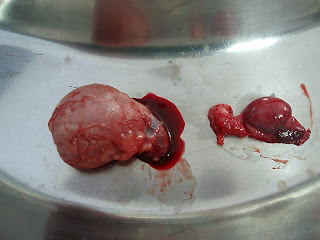How easy is it when you are slicing up the ham, with your dog sitting right next you, looking at you with their big eyes, to slice a bit extra and give them a tid bit. Or after the family leaves, and you are cleaning up - all of those leftovers might as well go to your dog, rather than chuck them away for landfill. It won't hurt will it.
 |
| "Oops - how did that slice of ham go from my hand to my pet!" |
If it wasn't for Piper's food allergies, even if I did know better, I would've slipped her a piece or three of leftovers. Like many of other loving pet owners - I am human too. It is hard looking at those big beautiful eyes, and not succumbing to them.
It's also human (and Aussie) to think "She'll be right mate!". After all, alot of us grew up with our pets just eating the leftovers anyway, and they seemed to do perfectly fine.
At work today, I had several people ask me if it was OK for their pet to have eaten the leftover pork, or ham.
The short answer is "No, its not OK".
The long answer is - ham is very high is salt and fat, and roast pork is equally usually very fatty with extra herbs and spices. They, with the leftover fat of steaks, and the sausages from the BBQ, are the more common causes of a very common summer digestive problem, called Pancreatitis.
 |
| This is NOT OK! |
Pancreatitis is an expensive but in many cases, a preventable problem. At this time of year, no matter how much we love our animals, there is no need for many pets to succumb to this terrible disease.
Sadly, there are also many animals who are just prone to the condition, and even on a normal diet, may get sick and unwell.
So exactly what is Pancreatitis? It is an inflammation of the pancreas, which is a small organ that lies parallel to the upper part of the small bowel. When it is inflamed, it tickles the intestine, and the adjacent stomach and liver.
What signs will you see? With many pets with low grade chronic pancreatitis, all you may see is the occasional vomit. For others, with severe acute pancreatitis, there may be severe vomiting, diarrhoea, lethargy, abdominal pain and fever.
For more information on pancreatitis itself, click here.
So, what should you do if you were a bit naughty, gave your pet a few too many fatty treats, but they seem OK?
Well, the best thing you can do is to switch immediately to a low fat highly digestible food - such as cooked chicken with yoghurt.
Feed small amounts often, as we do not want to overstimulate the pancreas, but we do want to give the intestinal lining nutrition.
Other options include steamed white fish.
If cooking is not your thing, then come in and ask - we have several tasty options available.
 |
| A low fat but tasty alternative. |
So what should you do if your pet is vomiting and/or has diarrhoea and/or is lethargic and/or not eating much?
See a vet ASAP - Pancreatitis is not a condition that you should wait and see if they are going to get better on their own.
If it is severe or aggressive enough, complications can arise - such as adhesions, pancreatic abscesses, liver damage or even death.
Treatment often involves fluid therapy, pain relief, gastric support and of course, exceptional veterinary and nursing care that every pet deserves.
Once you have been through it with your pet, you will appreciate how something so little, like a tiny bit of ham can cause serious harm. If there is one thing that our pets deserve, it is to be loved and looked after - and giving them ham, pork, sausage or fatty offcuts is not the way to do it.
I am Dr Liz, the mad vet from Bellambi. Wishing all pets to stay happy and healthy this Christmas as we head towards 2017!
Take it easy everyone.















